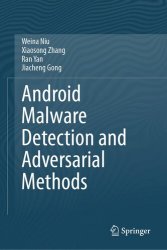Android Malware Detection and Adversarial Methods
- Добавил: literator
- Дата: 25-05-2024, 20:02
- Комментариев: 0
 Название: Android Malware Detection and Adversarial Methods
Название: Android Malware Detection and Adversarial MethodsАвтор: Weina Niu, Xiaosong Zhang, Ran Yan
Издательство: Springer
Год: 2024
Страниц: 197
Язык: английский
Формат: pdf (true), epub
Размер: 10.1 MB
The rise of Android malware poses a significant threat to users’ information security and privacy. Malicious software can inflict severe harm on users by employing various tactics, including deception, personal information theft, and device control. To address this issue, both academia and industry are continually engaged in research and development efforts focused on detecting and countering Android malware. This book is a comprehensive academic monograph crafted against this backdrop. The publication meticulously explores the background, methods, adversarial approaches, and future trends related to Android malware.
This book is divided into four parts, covering all aspects of Android malware detection. The first part is an overview of Android malware. Through an overview of Android malware detection, it provides readers with an overall understanding of this field.
The second part is the general method of Android malware detection, including signature-based malware detection method, behavior-based malware detection method, and artificial intelligence-based malware detection method. These methods are currently widely researched and applied technologies. By introducing their principles and applications in detail, readers can have an in-depth understanding and apply them to actual malware detection work.
The third part is Android malware detection and adversarial methods, including static adversarial methods in Android, dynamic adversarial methods in Android, and adversarial technology in Machine Learning. These methods are designed to help readers understand and respond to the adversarial behavior of malware and improve detection accuracy and effectiveness.
Finally, the fourth part is about the future trends of Android malware. By discussing future development trends, it shows readers the cutting-edge research and development directions in this field. Through this part, we want to show that as technology continues to progress and evolve, Android malware detection techniques need to be constantly updated and improved to adapt to changing security threats.
Machine Learning and Deep Learning techniques play a crucial role in the detection of Android malware, making them indispensable for the future. These technologies are able to identify and predict malware behavior more accurately by learning and understanding the behavioral patterns and features of malware.
Machine Learning techniques can learn the features and behavioral patterns of malware by training models to achieve automatic detection and identification of malware. This method can greatly improve the efficiency and accuracy of malware detection and reduce the need for human intervention. Deep Learning technology, on the other hand, can deeply learn and understand the complex behavior and hidden features of malware through deep neural network models. This approach can effectively identify complex and hidden malware and improve the depth and breadth of malware detection.
For example, Machine Learning-aided Android Malware Classification proposes two Machine Learning-aided methods for static analysis of Android malware. The first approach is based on permissions and the other on source code analysis using bag-of-words representation models. A Machine Learning Approach to Android Malware Detection extracts a number of features and trains a class of support vector machines in an offline (off-device) manner in order to utilize the higher computational power of a server or a cluster of servers.
As of now, Artificial Intelligence techniques such as Machine Learning and Deep Learning have been widely used for Android malicious code detection, and with the continuous development of Artificial Intelligence and Machine Learning techniques, the future of Android malware detection will be more dependent on these techniques. By training a large number of data samples from which malware features are extracted, including static features (e.g., file size, permission request, etc.) and dynamic features (e.g., runtime behavior, network communication, etc.), the Machine Learning model can automatically identify the features and behavioral patterns of the malware, thus improving the accuracy and efficiency of the detection. Although there have been a large number of related research results showing that Machine Learning and Deep Learning have good results in the field of Android malware detection, there are still many problems in it.
By engaging with this book, readers will gain not only a global perspective on Android malware detection and adversarial methods but also a detailed understanding of the taxonomy and general methods outlined in each part. The publication illustrates both the overarching model and representative academic work, facilitating a profound comprehension of Android malware detection.
Скачать Android Malware Detection and Adversarial Methods
[related-news] [/related-news]
Внимание
Уважаемый посетитель, Вы зашли на сайт как незарегистрированный пользователь.
Мы рекомендуем Вам зарегистрироваться либо войти на сайт под своим именем.
Уважаемый посетитель, Вы зашли на сайт как незарегистрированный пользователь.
Мы рекомендуем Вам зарегистрироваться либо войти на сайт под своим именем.
